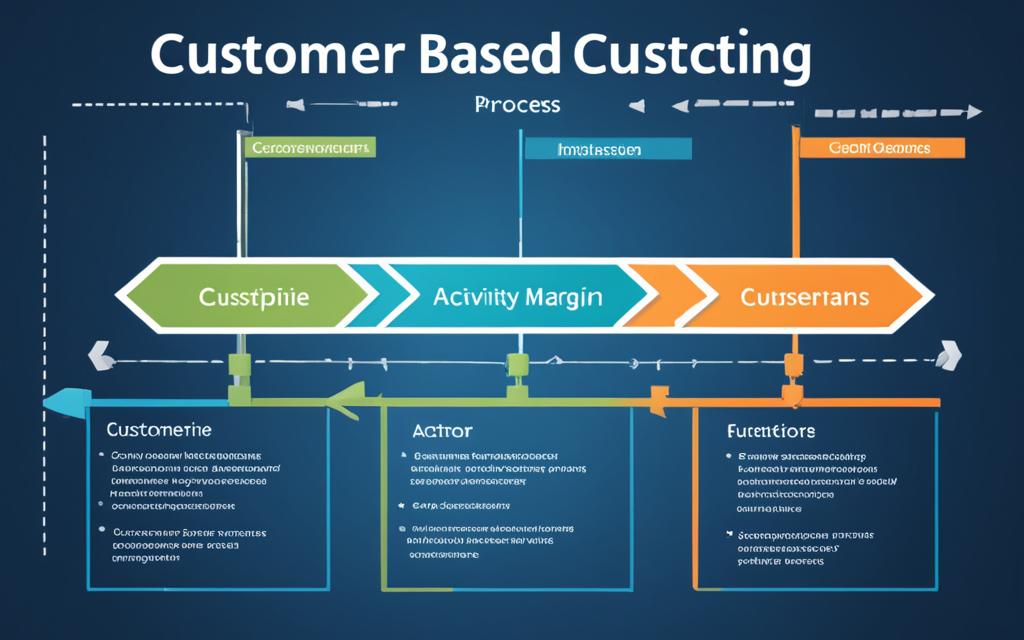In activity-based costing, we look at the difference between what we earn from a customer and the costs of serving them. This difference is called the customer margin. It’s a key figure for checking if a customer is profitable. To work out the customer margin, we add up costs like direct materials and labor, batch and order processing, plus customer service. Then, we take these total costs away from the sales revenue. This tells us the customer margin. It helps us see which customers bring in the most money and which don’t. Making these comparisons allows businesses to choose wisely where to focus their efforts1.
Key Takeaways:
- Customer margin is the difference between sales revenue and costs in activity-based costing.
- Cost components such as direct materials, direct labor, and overhead are considered to compute customer margin.
- Customer margin helps identify the profitability of individual customers.
- Activity-based costing enables businesses to make informed decisions based on customer profitability.
- Identifying profitable and unprofitable customers helps allocate resources effectively.
Understanding the importance of customer margin in activity-based costing is just the start. Next, we’ll dive into how to calculate this margin step by step.
Steps to Compute Customer Margin in Activity-Based Costing
To figure out customer margin using activity-based costing, you should follow a certain method. Here are the key steps you need to take:
-
Find out how much sales revenue comes from each customer.
-
Look into the various costs of serving each customer. These include direct materials, direct labor, support for direct labor, batch processing, order handling, and the overheads for customer service.2
-
Work out the full cost for every customer by adding up these costs.
-
Deduct the total cost from the sales revenue to get the customer margin.
By taking these steps, companies can clearly understand their customer margin from activity-based costing. This knowledge helps them make better choices for their strategy.
Image showing how to calculate customer margin in activity-based costing
Importance of Computing Customer Margin in Activity-Based Costing
Understanding customer margin in activity-based costing is key for businesses. It sheds light on customer profitability. This makes it possible for companies to spot their most and least profitable customers. By assigning overhead costs to products or services based on their use3, this approach pinpoints the true cost of serving each customer. Thus, businesses can concentrate on lucrative customers and reconsider their approach to the less profitable ones, boosting overall profits.
Computing customer margin also reveals the cost structure of serving varied customers. Unlike traditional cost systems that use direct labour hours or material costs4, activity-based costing accounts for the differing demands each customer places on resources. This lets businesses align their costs more accurately with their pricing strategies [source]. By grasping the actual costs, firms can tweak their prices to reflect the true expenses3. Hence, they manage costs better and make smarter decisions.
Furthermore, calculating customer margin is crucial for assessing marketing and sales strategies. By examining how different customer segments perform, companies can see how their marketing and sales efforts affect profits. This leads to refined strategies and focusing on the most profitable areas, enhancing revenue and margins. Activity-based costing offers the insights needed to turn customer profitability studies into effective actions [source].
In essence, computing customer margin via activity-based costing is vital for firms. It helps identify profitable customers, refine pricing strategies, and assess marketing effectiveness. With the data from activity-based costing, companies can decide wisely to boost profitability and succeed in the long run.
FAQ
What is customer margin in activity-based costing?
In activity-based costing, the customer margin is the gap between what a customer brings in and what they cost to serve.
How do you compute customer margin in activity-based costing?
First, figure out each customer’s sales revenue. Next, note all the costs for serving them. Add these costs up to get the total.
Then, take away the total cost from the sales revenue. This gives you the customer margin.
Why is computing customer margin in activity-based costing important?
Knowing the customer margin helps find out which customers are making you money and which aren’t. This way, firms can invest in profitable ones.
It unveils the costs of different customers, aiding in setting the right prices. It also checks if sales strategies are working by looking at customer profits.
Source Links
- https://www.investopedia.com/terms/a/abc.asp – Activity-Based Costing (ABC): Method and Advantages Defined with Example
- https://www.cliffsnotes.com/tutors-problems/Managerial-Accounting/52109890-a-What-is-the-customer-margin-under-activity-based-costing-when/ – (a) What is the customer margin under activity-based costing when…
- https://www.phocassoftware.com/resources/blog/activity-based-costing – How activity-based costing (ABC) improves budgets and profitability
- https://hbr.org/1991/05/profit-priorities-from-activity-based-costing – Profit Priorities from Activity-Based Costing


















